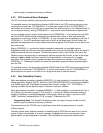
Cache Operations 4-7
and proceed sequentially to the last word of the line. In both types of fills, the fill buffer, when full, is
transferred to the data cache array. The cache line is marked valid when it is filled.
Loads that result in a line fill, and loads from non-cachable memory, are sent to a GPR. The
requested byte, halfword, or word is sent from the DCU to the GPR from the fill buffer, using a cache
bypass mechanism. Additional loads for data in the fill buffer can be bypassed to the GPR until the
data is moved into the data array.
Stores that result in a line fill have their data held in the fill buffer until the line fill completes. Additional
stores to the line being filled will also have their data placed in the fill buffer before being transferred
into the data cache array.
To complete a line fill, the DCU must access the tag and data arrays. The tag array is read to
determine the tag addresses, the LRU line, and whether the LRU line is dirty. A dirty cache line is one
that was accessed by a store instruction after the line was established, and can be inconsistent with
external memory. If the line being replaced is dirty, the address and the cache line must be saved so
that external memory can be updated. During the cache line fill, the LRU bit is set to identify the line
opposite the line just filled as LRU.
When a line fill completes and replaces a dirty line, a line flush begins. A flush copies updated data in
the data cache array to main storage. Cache flushes are always sequential, starting at the first word
of the cache line and proceeding sequentially to the end of the line.
Cache lines are always completely flushed or filled, even if the program does not request the rest of
the bytes in the line, or if a bus error occurs after a bus interface unit accepts the request for the line
fill. If a bus error occurs during a line fill, the line is filled and the data is marked valid. However, the
line can contain invalid data, and a machine check exception occurs.
4.3.2 DCU Write Strategies
DCU operations can use write-back or write-through strategies to maintain coherency with external
cachable memory.
The write-back strategy updates only the data cache, not external memory, during store operations.
Only modified data lines are flushed to external memory, and then only when necessary to free up
locations for incoming lines, or when lines are explicitly flushed using dcbf or dcbst instructions. The
write-back strategy minimizes the amount of external bus activity and avoids unnecessary contention
for the external bus between the ICU and the DCU.
The write-back strategy is contrasted with the write-through strategy, in which stores are written
simultaneously to the cache and to external memory. A write-through strategy can simplify
maintaining coherency between cache and memory.
When data address translation is enabled (MSR[DR] = 1), the W storage attribute in the TLB entry for
the memory page controls the write strategy for the page. If TLB_entry[W] = 0, write-back is selected;
otherwise, write-through is selected. The write strategy is controlled separately for each page.
“Translation Lookaside Buffer (TLB)” on page 7-2 describes the TLB.
When data address translation is disabled (MSR[DR] = 0), the Data Cache Write-through Register
(DCWR) sets the storage attribute. Each bit in the DCWR (DCWR[W0:W31]) controls the write
strategy of a 128MB storage region (see “Real-Mode Storage Attribute Control” on page 7-17). If
DCWR[W
n
] = 0, write-back is enabled for the specified region; otherwise, write-through is enabled.
Programming Note: The PowerPC Architecture does not support memory models in which


















